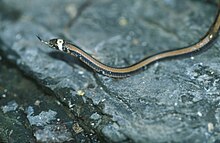Sinomicrurus sauteri
| Sinomicrurus sauteri | |
|---|---|

| |
| Scientific classification | |
| Kingdom: | Animalia |
| Phylum: | Chordata |
| Class: | Reptilia |
| Order: | Squamata |
| Suborder: | Serpentes |
| Family: | Elapidae |
| Genus: | Sinomicrurus |
| Species: | S. sauteri
|
| Binomial name | |
| Sinomicrurus sauteri (Steindachner, 1913)
| |
| Synonyms[2] | |
Sinomicrurus sauteri (common names: Taiwan coral snake,[3] oriental coral snake[2] and Formosa coral snake[4]) is a highly venomous[2][3] species of snake in the family Elapidae.[1][2][3][5] The species is endemic to Taiwan and known from southern and central Taiwan at elevations of 500–1,500 m (1,600–4,900 ft) above sea level.[1][3]

Etymology[]
The specific name, sauteri, is in honor of German entomologist Hans Sauter (1871–1943).[6]
Description[]
S. sauteri grows to 98 cm (39 in) in total length (including tail).[3] The upper side of the body is dark brown or crimson, and has three black longitudinal stripes from neck to tip of tail, of which the mid-dorsal stripe is narrower than the lateral ones.[3]
Venom[]
Sinomicrurus sauteri is highly venomous. Although it is not aggressive and very few reports of attacks have been reported, its venom is potentially life-threatening.[3]
Reproduction[]
Sinomicrurus sauteri is oviparous.[1][3]
Habitat[]
Sinomicrurus sauteri may be found in forests or meadows in mountainous area at lower or middle altitudes. It is typically nocturnal.[1]
Conservation status[]
S. sauteri is a rare species[3] protected by the law.[1][3] It is not considered threatened.[1]
References[]
- ^ a b c d e f g Zhou, Z.; Rao, D.-q.; Lau, M.; Jiang, J.; Ji, X. (2012). "Sinomicrurus sauteri". IUCN Red List of Threatened Species. 2012: e.T192173A2051007. doi:10.2305/IUCN.UK.2012-1.RLTS.T192173A2051007.en. Retrieved 20 November 2021.
- ^ a b c d Sinomicrurus sauteri at the Reptarium.cz Reptile Database. Accessed 3 March 2016.
- ^ a b c d e f g h i j Breuer, Hans & Murphy, William Christopher (2009–2010). "Sinomicrurus sauteri ". Snakes of Taiwan. Retrieved 3 March 2016.
- ^ "帶紋赤蛇 Formosa Coral Snake; Hemibungarus sauteri". National Academy for Educational Research, Taiwan. 2012. Retrieved 9 November 2020.
- ^ Li Hsiang-Ying. Shao, K.T. (ed.). "Sinomicrurus sauteri (Steindachner, 1913)". Catalogue of life in Taiwan. Biodiversity Research Center, Academia Sinica, Taiwan. Retrieved 4 March 2016.
- ^ Beolens, Bo; Watkins, Michael; Grayson, Michael (2011). The Eponym Dictionary of Reptiles. Baltimore: Johns Hopkins University Press. xiii + 296 pp. ISBN 978-1-4214-0135-5. (Sinomicrurus sauteri, p. 233).
Further reading[]
- Slowinski, Joseph B; Boundy, Jeff; Lawson, Robin (2001). "The Phylogenetic Relationships of Asian Coral Snakes (Elapidae: Calliophis and Maticora) Based on Morphological and Molecular Characters". Herpetologica 57 (2): 233-245. (Sinomicrurus sauteri, new combination).
- Steindachner F (1913). "Über zwei neue Schlangenarten von Formosa ". Anzeiger der Kaiserlichen Akademie der Wissenschaften, Mathematisch-Naturwissenschaftliche Klasse 50: 218-220. (Oligodon sauteri, new species, pp. 219–220). (in German).
- IUCN Red List least concern species
- Sinomicrurus
- Snakes of Asia
- Reptiles of Taiwan
- Endemic fauna of Taiwan
- Reptiles described in 1913
- Taxa named by Franz Steindachner
